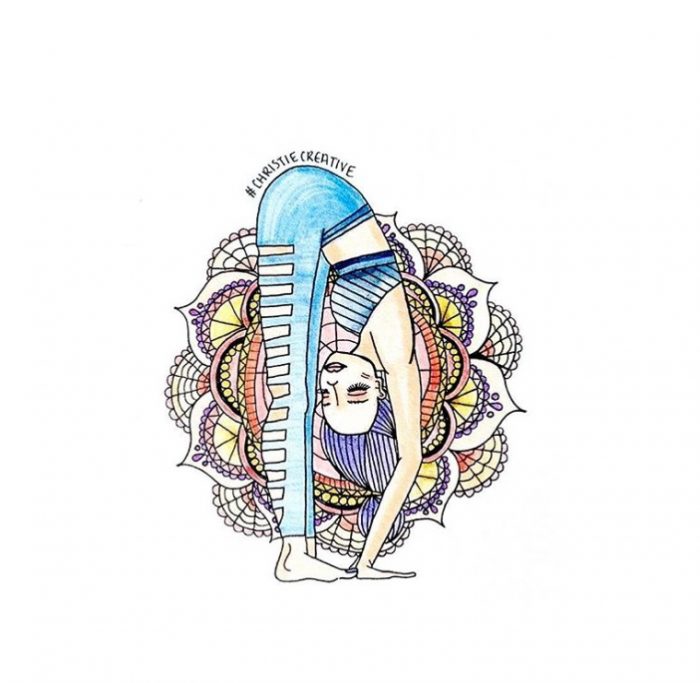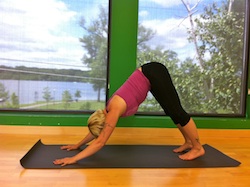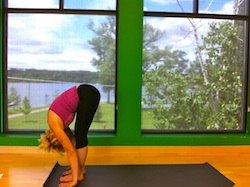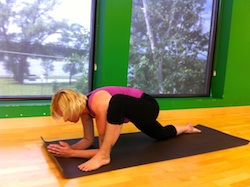I was surfing YouTube last week for inspiration and came across this sequence called The Octopus Series by Mystic Body Works, beautifully demonstrated by Rodolfo Mari.
I love the fluidity and grace of it, the winding and unwinding. Done with a steady and strong flow and attention to transitions it really does resemble an octopus moving through the water.
I took the sequence and constructed an hour long class around it, using the original sequence as the apex of the class. For this class I chose to loosely follow Shiva Rea‘s concept of Mandala of Asanas for overall class structure. If you’re not familiar with this, no worries, just follow the sequence as outlined below.
If you like a creative flow I definitely recommend doing some workshops with Shiva or any of her teacher trainers. I was introduced to this way of sequencing during a weekend workshop with Simon Park. As a dancer, I immediately connected to fluid grace of it. I have used variations of this sequence for all of my classes this week including; Power Vinyasa, Hot Yoga, Mixed Level Vinyasa and Gentle Flow.
The sequence in it’s entirety is a 60 minute intermediate (or mixed level with options) class moving at a relatively quick pace, about 3-5 breaths per hold and using the classic Ashtanga vinyasa transition with the option to float the leg if appropriate. If you are familiar with any Power or Vinyasa style you probably know what I’m talking about—except Bikram. I’ve never done Bikram but I’ve heard they don’t do vinyasa. Other transitions include child’s pose, downward facing dog and mountain pose.
Ways to modify:
-Follow the portions of the sequence in Italics only for a gentle class, eliminating vinyasa transitions except for those in Surya Namaskara.
-Reduce the number of vinyasas to transition or eliminate them completely.
-Vary the pace and length of holds to suit your class needs.
-Child’s pose and cat/cow make nice transitions for a gentle class and rest periods for hot classes.
-To moderately reduce the intensity of the class, eliminate the sequences that are in bold type. These are the highest intensity, deepest stretches and twists. All other sections are preparations for those that are in bold type. Eliminating any other than those that are in bold type could prevent you/your students from getting the most they can out of those more intense movements and may result in injury.
Note: T=transition
Teachers, I highly recommend that you do the sequence yourself and become comfortable with it before attempting to teach it.
Read the following legal stuff before you go further:
Not all exercise is suitable for everyone. This or any exercise program may result in injury. Consult with your doctor before use. Yoga instructors teaching this sequence to students should have comprehensive yoga training and liability insurance. To reduce the risk of injury, never force or strain yourself or your students during exercise. If you feel pain, stop and seek medical attention if necessary.
This sequence may not be appropriate during pregnancy. Any instructor teaching yoga to pregnant women should have specialized training in Prenatal Yoga and should provide appropriate modifications for contraindicated poses. Those with special health considerations should consult their medical practitioner before performing any exercise.
elephantjournal, Yoga in the Valley/Tracy Johnson cannot guarantee that this yoga program is suitable and safe for every individual. Any liability, loss or damage in connection with the use of the following yoga sequence, including but not limited to any liability, loss or damage arising from the performance of the exercises demonstrated here is expressly disclaimed.
Octopus Series – Revised
Warmup:
- –Balasana (child’s pose)
- –Marjaryasana/Bitilasana (cat/cow)
- –Adho Mukha Svanasana (downward facing dog)
- —Uttanasana var. – feet wider than hips, knees soft, hold opposite elbows, gentle sway from side to side (standing forward bend variation)
- –Tadasana (mountain pose)
—Surya Namaskara A (Three to five times)
—Surya Namaskara B var. (Three times: 1st=Vira 1, 2nd=Vira 2, 3rd=Vira 2 to Trikonasana)
Sequence 1:
- –Uttanasana (standing forward fold)
- –Standing Ustrasana (camel pose variation)
- –Uttkatasana (chair pose)
- –Parivritta Uttkatasana R&L (revolved chair)
- –Standing Back Bend with fingers laced behind back
- –Uttanasana Var. – deep bend in knees, palms up with elbows close to body, back of hands rest on floor fingers pointing forward, belly rests on thighs
- –Crescent Warrior (aka Standing Lunge)
- –Parivritta Parsvakonasana var. – back leg remains in lunge position, heel lifted and pressing back, right hip slightly internally rotated (revolved side angle variation/revolved crescent lunge)
- –Parsvottanasana (pyramid/intense side stretch)
- –Anjaneyasana var. (Low Lunge) – hands on mat on either side of foot
- –Adho Mukha Svanasana
- –Adho Mukha Svanasana Var./3 Legged Dog—right leg lifted
- –Anjaneyasana (low lunge)
- –Anjaneyasana variation—bow torso forward, forearms down
- –Anjaneyasana variation/Eka Pada Rajakapotasana II
- –T (step back foot forward behind front foot)
- –Garudasana (eagle pose)
- –Parivrtta utkatasana variation
- –Uttanasana
Repeat sequence 1 on left
Sequence 2: (see video for sequence – hold poses for three to five breaths)
- –Balasana
- –Vajrasana w/backbend (thunderbolt)
- –Bharadvajasana var. right and left (kneeling twist)
- –Vajrasana w/backbend
- –Balasana
- –Anjaneyasana
- –Anjaneyasana var. – externally rotate R leg, reach back w/R arm, catch foot, pull heel to hip
- –Parsvotanasana low var.
- –Hanumanasana (splits)
- –Three Legged Dog
- –Eka Pada Rajakapotasana w/backbend (1 leg king pigeon)
- –Eka Pada Rajakapotasana w/forward fold
- –Eka Pada Rajakapotasana w/ quad stretch
- –Gomukhasana w/forward fold (cow face pose)
Repeat sequence on left
Sequence 3: right & left
*Same as sequence 2 with no holds
*pace will not necessarily be 1 breath=1 movement but movement should be fluid, continuous and connected to breath
*see video for reference
Closing: (for gentle class you might consider using props for the closing sequence)
- –Setu Bandha Sarvangasana (bridge)
- –Ardha Parvana Muktasana (wind relieving pose)
- –Jatara Parivartanasana (reclining twist)
- –Savasana (resting pose)
~
Editor: Hayley Samuelson.















Read 7 comments and reply